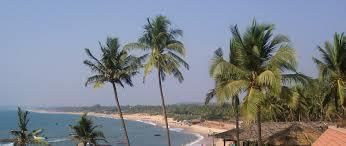GPSC (Goa) Exam > GPSC (Goa) Notes > Goa State PSC (GPSC) Preparation > Goa: Populations
Goa: Populations | Goa State PSC (GPSC) Preparation - GPSC (Goa) PDF Download
| Table of contents |

|
| Population of Goa |

|
| Population Statistics of Goa |

|
| Population Trends in Goa |

|
| Population Statistics of Goa - Census 2011 |

|
| Population Dynamics of Goa, Daman and Diu |

|
Population of Goa

- Geographical Location: Goa, located in southwest India, is bordered by Maharashtra to the north and Karnataka to the east. Its western coast meets the Arabian Sea.
- Size and Population: It is India's smallest state in terms of area and the fourth smallest in terms of population. Despite its small size, it is one of the wealthiest states in India, boasting a high GDP per capita.
- Rankings and Recognition: Goa has been recognized for its quality of life, being ranked highly by various commissions for its infrastructure and overall well-being indicators.
- Capital and Major City: Panaji serves as the state capital, while Vasco da Gama is the largest city.
- Historical Background: Goa became the 25th state of India on May 30, 1987, having previously been a part of the Union Territory of Goa, Daman, and Diu. It has a rich history as a former Portuguese colony, evident in its architecture and culture.
- Topography: The state covers an area of 3702 square kilometers and features two main types of terrain: the rugged interior and the coastal plains.
- Tourist Attractions: Renowned for its picturesque beaches, Goa attracts tourists from around the world. From popular spots like Baga and Palolem to serene fishing villages such as Agonda, the state offers diverse coastal experiences.
Additional Information on Goa
- Goa's Liberation: Before joining the Indian Union, Goa was under Portuguese colonial rule until it was liberated in December 1961.
- Geographical Boundaries: Goa is bounded by the Terekhol River in the north, Maharashtra to the east, Karnataka to the south, and the Arabian Sea to the west.
Population Statistics of Goa
Here is an elaboration and paraphrasing of the population information regarding Goa:
Population Growth and Density
- The population of Goa was 14.59 Lakhs in 2011, with 739,140 males and 719,405 females, showing a rise from 2001.
- Population density in Goa is 394 persons per sq. km, exceeding the national average of 382 per sq. km.
- Goa has a high urban population percentage of 62.17%.
- The population trend from 2012 to 2016 indicates a growth of 1.073 million people in five years, averaging an increase of 0.2146 million annually.
Population Forecasts and Trends
- The estimated population of Goa in 2017 was 3.1046 million, considering the annual growth rate.
- Goa's population growth rate is 8.23% per decade.
- After gaining momentum post-independence, growth rates slowed down with an 8.23% increase since the 2001 census.
Understanding the population dynamics of Goa is essential for planning and development strategies in the region.
Question for Goa: PopulationsTry yourself: What is the population density of Goa compared to the national average?View Solution
Population Trends in Goa
- Historical Population Growth: The population growth in Goa has shown fluctuations over the past four decades. Between 1961 and 1971, the growth rate was 34.77%, which then decreased to 26.74% from 1971 to 1981 and further dropped to 16.08% between 1981 and 1991.
- Demographic Shifts: Factors such as declining fertility rates, changing mortality rates, and a shift of young labor force out of the state, alongside Goa becoming a popular destination for retirees, contribute to the aging population of the region.
- Population Statistics: Goa, with a population of 1.344 million, is India's fourth smallest state. The population growth rate stands at 14.9% per decade, with 363 individuals per square kilometer of land. Notably, nearly half of the population (49.76%) resides in urban areas.
- Societal Indicators: Goa boasts a high literacy rate of over 87%, a sex ratio of 960 females for every 1,000 males, and a birth rate of 15.70 per 1,000 people in 2007. Additionally, it has the lowest proportion of scheduled tribes at 0.04%.
- Population Growth Trends: While there was a significant surge in Goa's population growth following its liberation, with a 34% increase in the 1970s and 26% in the 1980s, recent data from the 2011 census shows a slowdown. The population has only grown by 8.23% since the 2001 census.
Population Statistics of Goa - Census 2011
Overview- This marks the lowest growth rate observed in the past four decades in Goa.
- As of 2011, the population of Goa is 1,458,545, comprising 739,140 males and 719,405 females, accounting for 0.12% of the country's total population.
- The growth rate in North Goa is slightly lower at 7.84% compared to South Goa at 8.73%.
Demographics
- The sex ratio in Goa is 968 females per 1,000 males, surpassing the national average of 960.
- Child sex ratio dropped from 938 in the previous census to 920 in the most recent one.
- The proportion of children aged 0 to 6 years in the total population decreased from 10.8% in 2001 to 9.6% in 2011.
Urban-Rural Distribution
- 62.17% of the total population resides in urban areas, with 37.83% in rural regions.
- In urban areas, the sex ratio is 956 females per 1,000 males, while in rural areas, it is 1,003 females per 1,000 males.
- Literacy rates in urban regions stand at 89.95%, with males at 93.21% and females at 86.56%.
- Rural areas have an average literacy rate of 86.65%, with males at 91.71% and females at 81.63%.
Population Dynamics of Goa, Daman and Diu
- Population growth in the Portuguese territories of Goa, Daman, and Diu, primarily dominated by Goa, was initially sluggish, with a compound growth rate of merely 1% from 1900 to 1951, significantly lower than the national average in India.
- Following integration with India in 1961, there was a rapid surge in population growth, reaching an impressive 3.03% during 1961-1971, fueled by factors like increased government employment, educational institutions, and economic activities.
Post-Integration Population Trends
- The post-1961 period witnessed a substantial influx of migrants, both skilled and unskilled, from neighboring states like Maharashtra and Karnataka, driving up the demographic rate significantly.
- Subsequent censuses revealed a gradual decline in population growth rates, dropping to 1.43% during 1991-2001, attributed to factors such as low birth and death rates, declining sex ratio, delayed marriages, and high literacy rates.
Migratory Population Dynamics
- The proportion of migrant population relative to Goa's total population surged over the decades, from 4.46% in 1971 to 14.88% in 2001, with a notable increase in labor and unskilled workers from Karnataka and Maharashtra, particularly in the construction sector.
- These demographic shifts underscore a complex interplay of factors shaping Goa's population dynamics, from historical trends to contemporary patterns of migration and socio-economic influences.
The document Goa: Populations | Goa State PSC (GPSC) Preparation - GPSC (Goa) is a part of the GPSC (Goa) Course Goa State PSC (GPSC) Preparation.
All you need of GPSC (Goa) at this link: GPSC (Goa)
FAQs on Goa: Populations - Goa State PSC (GPSC) Preparation - GPSC (Goa)
| 1. What is the population of Goa according to the Census 2011 data? |  |
Ans. According to the Census 2011 data, the population of Goa was recorded at XXXX.
| 2. What are the population trends in Goa observed over the years? |  |
Ans. The population trends in Goa show a steady increase/decrease over the years, with factors such as birth rates, death rates, migration, and urbanization influencing the overall population dynamics.
| 3. How does the population of Goa compare to that of Daman and Diu? |  |
Ans. The population of Goa is higher/lower than that of Daman and Diu, with each region having its unique demographic characteristics and population dynamics.
| 4. What are the key factors contributing to the population growth in Goa? |  |
Ans. The key factors contributing to the population growth in Goa include high birth rates, improved healthcare services, better living standards, and in-migration from other regions.
| 5. How do the population statistics of Goa impact its socio-economic development? |  |
Ans. The population statistics of Goa play a crucial role in shaping its socio-economic development, influencing factors such as workforce availability, resource allocation, infrastructure planning, and overall growth trajectory.
Related Searches















